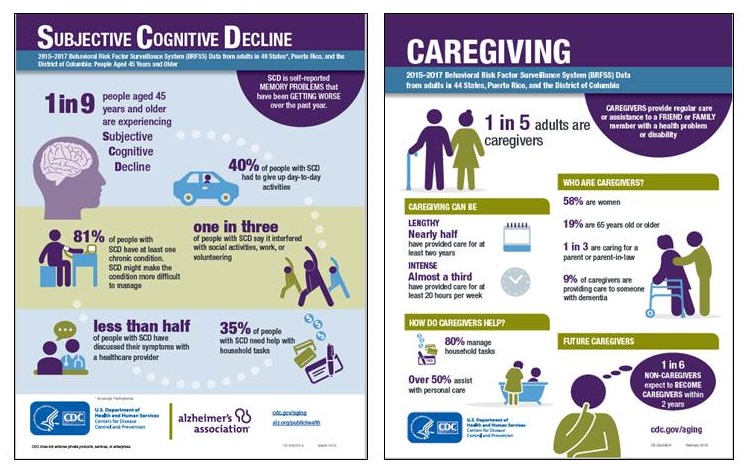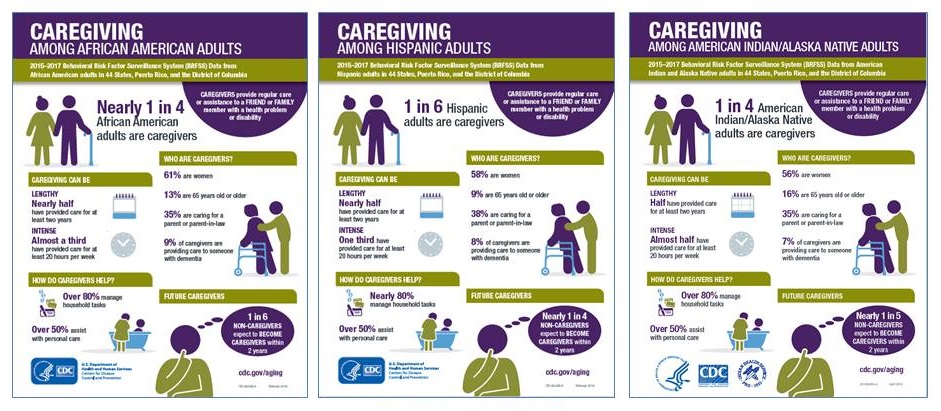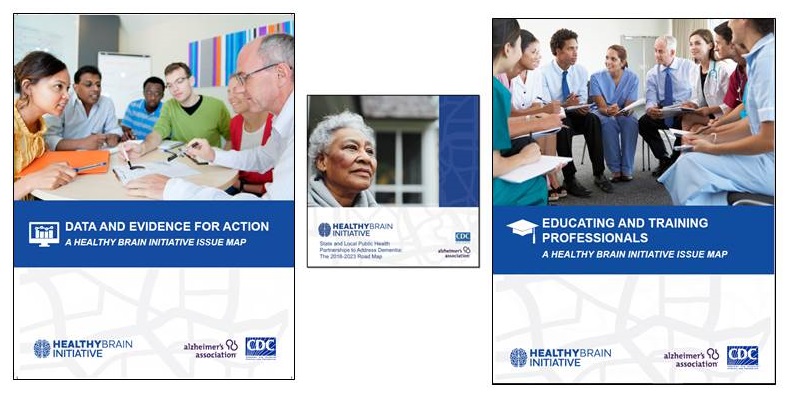Monday, April 29, 2019
Printer Friendly Version in PDF Format (13 PDF pages)
Long-Term Services and Supports Federal Update
Administration for Community Living
2019 Alzheimer' Disease Programs Initiative (ADPI) Expansion Grants
($3,489,465 )
- Memory Care Home Solutions (Missouri)
- Alzheimer's San Diego (California)
- Alzheimer's Greater Los Angeles (California)
- United Way of Tarrant County (Texas)
- The Regents of the University of California, San Francisco (California)
- Florida Atlantic University (Florida)
- Greenville Health System (South Carolina)
- BakerRipley (Texas)
- University of Hawaii (Hawaii)
Anticipated Program Outcomes
- Expansion of occupational health focused evidence based intervention program with addition of social workers to the process.
- Expansion of supports for persons living with dementia and caregivers through enhanced partnerships with law enforcement to include case consultation and training initiatives.
- Increased knowledge and preparedness to support caregiving for individuals living with Lewy Body Dementia.
- Expansion of behavioral symptom management approaches for linguistically-diverse and lower literacy caregivers.
- Expanded focus of efforts to identify and serve vulnerable/homebound individuals using dementia capable volunteers.
- Expanded dementia education/training for physicians and healthcare workers.
Administration on Aging
RAISE ACT UPDATE
- Invitations to nominated/selected Council members mailed late March
- Acceptances are in ethics review and vetting for being placed in Special Government Employee (SGE)
- Engaged in procurement process to secure logistics
- Working to stand up a resource and dissemination center to support the council
Administration for Community Living
National Alzheimer's and Dementia Resource Center
https://nadrc.acl.gov/
UPCOMING WEBINAR
The Messages We Send: Stigma Toward Persons Living with Dementia and How to End It
Tuesday, May 7, 2019, 2:00-3:00 PM ET
- Presenters
- Shana Stites, Psy.D., M.A., M.S., is a clinical psychologist and researcher at the University of Pennsylvania.
- Rev. Cynthia Huling Hummel, D.Min., is living with early stage dementia, diagnosed in 2016.
National Center for Law and Elder Rights Resource on Diminished Capacity and Alzheimer's Disease
- In the past 6 months, NCLER presented the following webinar trainings, of interest to professionals and caregivers working with individuals with diminished capacity and Alzheimer's Disease:
- Advance Planning Documents: Planning and Prevention
- Using Consumer Law to Protect Nursing Facility Residents
Indian Health Service
ADRD IN INDIAN COUNTRY
- Working with the VA Greater Los Angeles Area to re-establish training and mentoring for Caregiver Coaches (REACH into Indian Country).
- VA Office of Rural Health continues to provide Rural Interdisciplinary Team Training (RITT) for IHS and Tribal sites
- 15 trainings and counting.
- CDC Infographics on AI/AN Caregiving and AI/AN Subjective Cognitive Decline (based on AI/AN BRFSS data).
- CDC and Alzheimer's Association Healthy Brain Initiative Road Map for Indian Country scheduled for release May 13, 14 at NIHB.
- Honoring Elder Wisdom conference in Minnesota on April 2 in Walker MN, focusing on Alzheimer's Disease and Related Dementias.
- Presentation to the Secretary's Tribal Advisory Committee meeting on the status of Alzheimer's Care and Information in Indian Country, scheduled for May 8 (ACL).
Centers for Disease Control and Prevention
Data for Action
| Aggregate Infographics |
|---|
 |
| SCD Infographics https://www.cdc.gov/aging/data/index.htm Caregiving Infographic http://www.cdc.gov/aging/data/infographic/caregiving.html |
| 2017State Infographics |
|---|
 |
| SCD Infographics https://www.cdc.gov/aging/data/index.htm Caregiving Infographic http://www.cdc.gov/aging/data/infographic/caregiving.html |
| New Race/Ethnicity SCD Infographics |
|---|
 |
| https://www.cdc.gov/aging/data/index.htm |
| New Race/Ethnicity Caregiving Infographics |
|---|
 |
| https://www.cdc.gov/aging/data/index.htm |
HBI Road Map for State/Local Public Health
| New Issue Maps |
|---|
 |
| Issue Maps https://www.cdc.gov/aging/healthybrain/roadmap.htm |
| New Issue Maps |
|---|
 |
| Issue Maps https://www.cdc.gov/aging/healthybrain/roadmap.htm |
| Complete Series of Issue Maps |
|---|
 |
| Issue Maps https://www.cdc.gov/aging/healthybrain/roadmap.htm |
Long-term Care Subcommittee Update
Shari Ling, MD
CMS Administrator Issues Blog on Nursing Home Quality
- In April the CMS Administrator, Seema Verma, published a "blog" describing CMS's focus on assuring nursing home safety and quality through a five part Plan
- Staff are undertaking a comprehensive review of nursing home regulations, guidelines, internal structure, and processes
- The Plan aims to strengthen oversight, enhance enforcement, increase transparency, improve quality, and minimize burden
- The Administrator urged persons with knowledge of abuse or neglect in a nursing home to alert a supervisor, social worker, administrator, or doctor, and also highlighted the opportunity to follow facility grievance procedures
Information at: https://www.cms.gov/blog/ensuring-safety-and-quality-americas-nursing-homes
(Strategy 2.D)
National Partnership to Improve Dementia Care in Nursing Homes: Update
- Decrease of 38.9 percent to a national prevalence of 14.6 percent in Quarter 3 2018
- CMS acknowledges that circumstances exist where clinical indications for the use of antipsychotic medications are present and does not expect that the national prevalence of antipsychotic medication use will decrease to zero
 |
| Source: CMS Quality Measure, based on MDS 3.0 data. For more information, see the MDS 3.0 Quality Measures Users Manual. |
"Late Adopter" Update
- In March CMS issued a Memorandum to State Survey Agency Directors noting that since 2011 there has been a reduction of 38.9 percent in long-stay nursing home residents receiving an antipsychotic
- Despite this success, CMS identified about 1,500 facilities that had not improved antipsychotic medication utilization rates for long-stay nursing home residents, referred to as "late adopters"
- In 2017 CMS notified these facilities of this identification; as of January 2019 there are 235 late adopter nursing homes that have been cited for noncompliance related to unnecessary/psychotropic medications two or more times since 2016, and that have not shown improvement in their long-stay antipsychotic medication rates
- If a facility determined not to be in substantial compliance with requirements for Chemical Restraints, Dementia Care, or Psychotropic Medications during a survey, it is subject to enforcement remedies
- CMS is also looking for opportunities to engage with corporate chains that have significant numbers of nursing homes identified as late adopters
National Partnership to Improve Dementia Care in Nursing Homes: Late Adopters
- Decrease of 5.2 percent to a national prevalence, among late adopters, of 20.3 percent in Quarter 3, 2018
- Late adopters are nursing homes that had limited reduction rates, based upon Quarter 1, 2017 data
Note: The national prevalence rates for late adopters for quarters 2012Q3 and earlier were incorrect on previous reports; These errors have been corrected
 |
| Source: CMS Quality Measure, based on MDS 3.0 data. For more information, see the MDS 3.0 Quality Measures Users Manual. |
Updates to Nursing Home Compare
- In March CMS announced updates to Nursing Home Compare and the Five-Star Quality Rating System to strengthen the tool for consumers and caregivers to compare quality between nursing homes and identify areas they may want to ask about when choosing a facility
- In April CMS implemented changes including revisions to align the inspection process, enhance new staffing information, and implement of new quality measures (long-stay hospitalizations, emergency department transfers)
Information at: https://www.medicare.gov/nursinghomecompare/search.html
(Strategy 2.D)
Medicaid Home and Community-Based Services (HCBS) Heightened Scrutiny Revisions
- In March CMS issued guidance on implementation of the 2014 HCBS rule that required states to scrutinize group homes, certain assisted living facilities and other settings to make sure they meet "community-based" standards
- In 2017 CMS delayed implementation of the rule and applied a three year extension - now extended to 2022 - during which states may work with providers to complete remediation and comply; not meeting standards could mean a federal funding loss
- CMS outlined the factors that determine if a setting has the effect of isolating beneficiaries (e.g. limited interaction with broader community, limited beneficiary choice; isolated location)
Information at: https://www.medicaid.gov/federal-policy-guidance/downloads/smd19001.pdf
(Strategy 2.G)
AHRQ Update: Evidence SynthesesIn Progress
- Diagnosis and Treatment of Clinical Alzheimer's Type Dementia
- Protocol posted - https://effectivehealthcare.ahrq.gov/topics/alzheimers-type-dementia/protocol
- Draft will be posted for public comment in May
- Care Interventions for People with Dementia and Their Caregivers
- In partnership with NIA
- https://effectivehealthcare.ahrq.gov/topics/care-interventions-pwd/overview
- Will be opportunity to submit unpublished data when protocol is posted, which will be in May or June
- Draft will be posted for public comment in Winter 2020
Evidence SynthesesNew
- Prevention, Diagnosis, and Management of Inappropriate Opioid Use, Misuse, and Abuse in Older Adults
- Final report: Spring 2020
- Integrating Palliative Care with Chronic Disease Management in Ambulatory Care
- Draft report posted for public comment: Summer 2020
A 5-year Agenda for MCC
- Solution: A multifaceted initiative that draws on unique AHRQ resources and competencies and builds on our competencies and foundational work, comprised of three core sets of activities:
- Real-World Research to develop, implement, evaluate, effective models of care
- Placing the person at the center of care will reduce unnecessary or harmful care, improve health outcomes, increase efficiency, and produce practice generated evidence to fill knowledge gaps and continually improve care.
- Development/use of new data-driven tools of informatics to enhance care coordination and delivery of 360º, whole-person, patient-centered care
- Models will facilitate the use of technology (virtual visits, mobile Health, app-based support) to support care outside of the office, interoperable digital dashboards to support care management, and AI to identity optimal care for different constellations of multi-morbidity
- Nationwide dissemination and implementation using learning collaboratives and other dissemination vehicles to support scale up and spread of new models and technologies
- Real-World Research to develop, implement, evaluate, effective models of care
